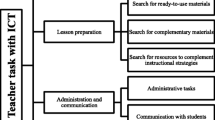Abstract
This paper reports of how ICT and a computer rich environment is used in a an upper secondary Swedish school to change traditional teacher and pupil work. A teacher and his classes were followed during one week. Observations, field notes, spontaneous conversations and formal interviews with the teacher and some pupils were made. Teachers' and pupils' work is affected in many ways. Some of the traditional teacher's work is here left to the pupils. In spite of the pedagogical intention to promote cooperation, the technology seems to strengthen individual work. ICT also seems to lead to the dissolution of boundaries between home and work place, working time and leisure time. The pupils' task to search for information on the Internet and transform it into personal knowledge is not an easy one. Discussion or evaluation of sources and origin of texts found on the Internet seems to be negligent.
Similar content being viewed by others
References
Ashman, A. F. and Gillies, R. M. (1997) Children's cooperative behavior and interactions in trained and untrained work groups in regular classrooms. Journal of School Psychology, 35(3), 261–269.
Bergman, M. (1999) På jakt efter högstadieelevers Internetanvändning (Searching for Lower Secondary Pupils' Use of Internet). Pedagogiska institutionen, Uppsala universitet.
Cuban, L. (1989) Neoprogressive visions and organizational realities. Harvard Educational Review, 59(2), 217–222.
Cuban, L. (1993) Computers meet classroom: Classroom wins. Teachers College Record, 59(2), 185–210.
Granström, K. and Einarsson, Ch. (1995) Forskning om liv och arbete i svenska klassrum (Research on Life and Work in Swedish Classrooms). Skolverket, Stockholm.
Hammersley, M. and Atkinson, P. (1995) Etnography.2nd edition, Routledge, London.
Jedeskog, G. (2001) “Maila mig sen!”(Mail Me Later!). LiU-PEK-R-226. IBV, Linköping universitet, Linköping.
Means, B. (ed.) (1994) Technology and Education Reform. Joey Bass, San Fransisco.
Miller, L. and Olson, J. (1994) Putting the computer in its place: A study of teaching with technology. Journal of Curriculum Studies, 26, 121–141.
Naeslund, L. (2001) Att organisera pedagogisk frihet (To Organize Pedagogical Freedom). IBV, Läspedagogiska institutet EMIR, rapport nr. 5, Linköpings universitet, Linköping.
Olson, J. (2003) ICT and the Practice of Teachers. Ethics and the Amplifying Powers of ICT. Key-note speech at ECER, Hamburg 17th-20th of September (manuscript).
Olson, J. (2000) Trojan horse or teacher's pet. Computers and the culture of the school. Journal of Curriculum Studies, 32(1), 1–8.
Perelman, L. J. (1992) School's Out: Hyperlearning, the New Technology, and the End of Education. Avon Books 1993, New York.
The Swedish National Agency for Education (2003) School Choice and its Effects in Sweden . Offprint of Report 230-A Summary. The Swedish National Agency for Education, Stockholm.
Skolverket (The Swedish National Agency for Education) (2001) Skolans datorer 2001 (Computers in the School in 2001). Skolverkets rapport nr.208. Skolverket, Stockholm.
Struck, P. (1996) Die Schule der Zukunft (The School of the Future). Wissenschaftliche Buchgesellschaft, Darstadt.
Tweddle, S. (1993) The future curriculum and information technology. Journal of Information Technology for Teacher Education, 2(1), 105–110.
Utbildningsdepartementet (1997/1998) Lärandets verktyg (Tools for Learning)-Ett nationellt program för IKT i skolan (A National Programme for ICT in Schools). Utbildningsdepartementet, Stockholm.
Watson, D. (1997) Information technology: Policy and practice. In Becoming a Teacher. Issues in Secondary Teaching, J. Dillon and M. Maguire (eds.). Open University Press, Buckingham.
Waks, L. J. (1997) The project method in postindustrial education. Journal of Curriculum Studies, 29(4), 391–406.
Windschitl, M. (1998) The WWW and classroom research: What path should we take? Educational Researcher, 27(1), 28–33.
Author information
Authors and Affiliations
Rights and permissions
About this article
Cite this article
Pedersen, J. Project Work in the Paperless School: A Case Study in a Swedish Upper Secondary Class. Education and Information Technologies 9, 333–343 (2004). https://doi.org/10.1023/B:EAIT.0000045291.99489.bd
Issue Date:
DOI: https://doi.org/10.1023/B:EAIT.0000045291.99489.bd




